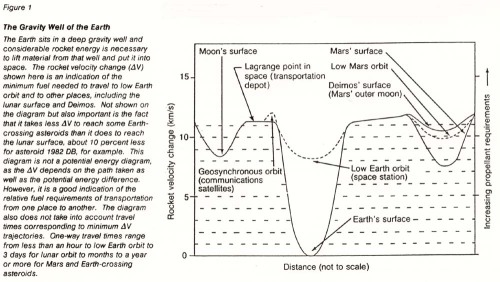Subscribe to the Grand Strategy Newsletter for regular updates on work in progress.
Discord Invitation
Planetary Constraints 6

Perhaps more obvious even than the limitations imposed upon the development of civilization by the spatial constraint (Earth is finite in regard to its surface area) and the temporal constraint (Earth is finite both as respects the total lifespan of the planet, as well as those subdivisions of the total life span of the planet that correspond to the habitable period and the civilizable period) is the gravitational constraint, which I initially described in Planetary Constraints 3:
Gravitation: Being on the surface of a planet means being at the bottom of a gravity well, and this imposes a constraint upon the extraterrestrialization of civilization proportional to the gravitation of the homeworld. A civilization on a planet of greater gravity than Earth would have to expand even greater energy resources that our civilization in order to liberate itself from its gravity well; a civilization on a planet of lesser gravity than Earth might be under less constraint in making the transition to a spacefaring civilization.
In the discussion of gravity as a limiting factor on civilization we need to acknowledge the apparent “Goldilocks effect” of Earth’s gravity. In so far as we concern ourselves with life arising on planetary surfaces, these planetary surfaces must have enough gravity to retain an atmosphere, but not so much gravity that escape from the gravity well would be impossible, or nearly so, thus certainly condemning any intelligent species to remain planet-bound.
According to our admittedly anthropocentric perspective, in this respect the Earth is “just right” – smaller Mars has retained very little of its atmosphere, whereas a larger Earth would begin to pose problems ranging from body structures so bulky that they would pose a serious challenge to being boosted into orbit, to gravity so strong that the first technologies a civilization acquires for flight may not result in flight, and escape velocity would be much more difficult to attain.
Our sister planet, Venus, is slightly smaller than Earth and not only has retained its atmosphere, but has retained perhaps too much of an atmosphere, resulting in a runaway greenhouse effect. So we know from this example that a somewhat smaller planet can retain an atmosphere. It also seems likely that a somewhat larger planet would not pose insurmountable obstacles to the technologies of flight and spaceflight, though it is difficult to identify the lower and upper bounds for planetary size as this size affects gravitation in a way that impacts the development of civilization.
From the perspective of the emergence of a spacefaring civilization from
a planetary civilization, the ideal gravitational well would be as
shallow as possible – just enough gravity to retain an atmosphere and
to make life possible, but as little as possible to make escape from the
planet surface require the least possible amount of energy expenditure.
It seems likely that, given the billions of planets we now know to orbit the billions of stars of our galaxy (and increase that by appropriate orders of magnitude to arrive at planets and stars in the universe entire), there must be smallish planets like Mars, or even small moons of larger planets, that have managed to retain a terrestrial-like atmosphere and on which the conditions for life have proved clement. A civilization arising on such a world would face a far lower barrier to extraterrestrialization and the transition to spacefaring civilization than those barriers we face on Earth. These barriers constitute the gravitational constraint upon civilization.
When in future posts I consider other possibilities for the origins of spacefaring civilizations – non-peer civilizations that originate with non-peer species that took different paths to encephalization and different paths to the development of technology – the gravitational constraint will appear as a parochial concern of planetary life forms that need not concern non-planetary life forms (if there are such). In the meantime, my focus will continue to be on peer species and peer civilizations, in order to illustrate the particular constraints posed on civilizations like ours by planets like ours.
